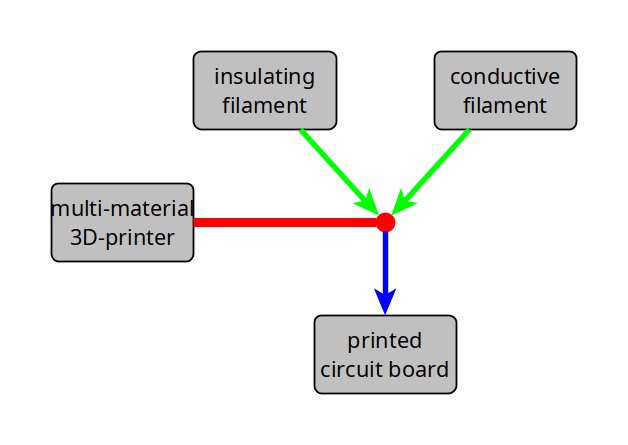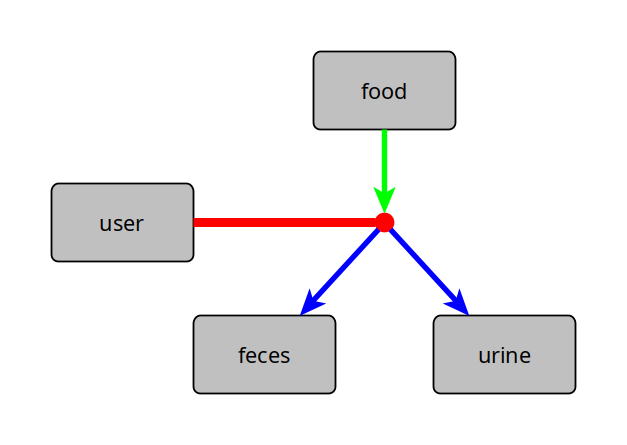
Execution
The practical implementation of the autopian mode of production is roughly divided in 3 phases:
- A Planning phase
- A Development phase
- A Distribution phase
Planning phase
This phase concerns the theoretical design of a complete Self-Sustainment-System. It is furtherly subdivided in 2 parts:
- A Descriptive phase
- A Corrective phase
Descriptive phase
This phase consists in drafting a detailed description (in the form of a graph) of the entire production chain that is normally involved in the production of all goods and resources needed by a normal human being in the current economic system.
The descriptive phase consists of the following steps:
1) Set the user as the graph's starting node.
2) Add each possible human need as a new node and link it to the user.
3) For every node added in this way, draw its "generative tree".
4) Merge together all repeated nodes.
5) For every node in the system, draw its "degenerative diagram".
6) Merge together all repeated nodes.
At the end of this phase, we'll end up with a massive graph that describes in detail modern society's entire production system.
The concepts mentioned in these steps are defined as follows:
Generative diagram
The "generative diagram" of an object/resource is a graph that describes all resources, tools and waste products involved in its production.
It is comprised of the following elements:
- A red dot connector.
- "Input" nodes representing all resources required for its production, linked to the connector by green arrows.
- "Mean" nodes representing all tools involved in its production, linked with the connector by red lines.
- "Output" nodes representing all final products (including the object itself) and byproducts, linked from the connector by blue arrows.

Example: generative diagram of "printed circuit board"
Degenerative diagram
The "degenerative diagram" of an object/resource is exactly like a generative diagram, except instead of representing its production, it represents its consumption;
- Input nodes represent the object itself (or any other object/resource involved in its use).
- Mean nodes represent the user.
- Output nodes represent waste products.

Example: degenerative diagram of "food"
Generative tree
The "generative tree" of an object is a graph that recursively describes the entire production chain involved in its production.
An object's generative tree is constructed through the following steps:
1) Set the object as the graph's starting node.
2) If the current node is a naturally occurring element, leave it as it is; otherwise, draw its generative diagram.
3) Mark the current node as "resolved".
4) If there are repeated nodes, merge them into 1.
5) If there are still unresolved nodes, choose one of them, and go to step 2); otherwise, the graph is finished.

Construction of a generative tree. Resolved nodes are marked by bold borders.
Corrective phase
This phase consists in extensively researching all available production technologies, and using the gathered information to progressively redesign the aforementioned production chain in such a way that the resulting graph is as small as possible, and entirely cyclical (aside for energy). The set of all production and recycling devices included in the final result will be the Self-Sustainment-System.
In order to achieve this goal, the following design strategies shall be adopted:
Device Miniaturization
Because of the centralized nature of the modern production system, any production center is designed with mass-production and mass-distribution purposes in mind, which requires huge establishments and machinery that are very difficult if not impossible to fit in a household scale;
since self-production does not require any such mass-production/distribution infrastructure, devices should be redesigned in order to be as small and easily portable as possible while still being able to achieve the same qualitative output of the original ones.
Examples:
- replacing traditinal coltivations and greenhouses with growrooms and/or growboxes
- replacing clean rooms with vacuum chambers
Process Simplification
One of the main obstacles to the goal self-production is the fact that modern appliances (especially in the field of electronics and informatics) involve a wide variety of components which require a wide variety of completely different manufacturing processes, industrial equipment and materials, making it highly impractical to replicate it in a single household;
therefore it is necessary to redesign technologies in order to simplify and streamline the productive process as much as possible; that is: to require the lowest possible variety of material resources, and the lowest possible number of manufacturing phases.
Examples:
- replacing motherboard-based PC architectures with system-on-chip ones
- replacing hard-disc memories with solid-state ones
- replacing mechanical keyboards with membrane keyboards
Process Unification
A huge hindrance to the achievement of complete self-production is the high degree of specialization of the modern productive process, that is: the fact that each specific product typically involves its own specific productive process that is usually separated from that of other ones, meaning that completely fulfilling the needs of a single person requires a huge variety of different equipment that is nearly to impossible to host in a regular household;
for this reason it is necessary to redesign technologies in order to unify the productive process as much as possible; this means, on one side: to develop technologies that are able to achieve the highest possible variety of products and, on the other side, to redesign common products in order to feature the lowest possible variety of materials and/or technologies involved between each other.
Examples:
- replacing normal 3D-printers with multi-material ones
- replacing inorganic materials with organic ones whenever possible
Development phase
This phase consists in the practical implementation of the various devices that comprise the Self Sustainment System, and relies on the following strategies:
Resources Hijacking
As explained in "explaination", the current system is designed in order to keep wealth flowing towards a handful individuals and away from common people, making it increasingly difficult for the latter to ever achieve the power required to make any meaningful impact on society. Therefore it is necessary to adopt measures that prevent this flow from returning back to the top as much as possible, and divert it towards the bottom instead, for example:
- refusing to pay taxes, and investing the money saved in this way to finance grassroots projects related to Project Autopia
- withdrawing money from banks, or other kind of centralized accounts
- boycotting big corporations whenever possible, and buying from smaller ones instead
Infrastructure Decentralization
As explained in "explaination", resources and means of production are currently in the process of being more and more centralized into the hands of big corporations. It is therefore imperative to revert this process before it's too late by start buying resources and means of production (and recycling) as much as possible from those who have, and reselling them at the lowest possible price to those who lack them.
Gaining the collaboration of small and medium enterprises will be crucial in this process because their much greater availability of capital (compared to regular workers/consumers) will allow them to function as "links" bridging the gap between big corporations and the general public making those resources and means more easily and economically available to the latter.
In particular, they shall be educated to resist any acquisition attemps by bigger companies/corporations, and to refuse selling any one of their critical assets or infrastructure to them.
Distribution phase
This phase regards the global distribution and spreading of the finished products (that is.: the S.S.S. devices).
The following are some strategies that might make this easier:
Casualization
One of the main factors that determine whether a given technology will be successful or not is how easily accessible, understandable and usable it is to the average person; this is why disempowering and centralizing technologies are getting more and more widespread despite their negative potential on human rights;
in order to win the race it is of the utmost importance to make the new technologies as easy as possible to get, to understand and to use; they should be designed in order to be accessible even to someone without any technological background and accompanied by very clear and straightforward manuals/tutorials.
Integrated Package Distribution
In the early phases of the autopian revolution, people will probably not see the need of a Self Sustainment System, since they can still satisfy all their immediate needs by just paying for them rather than indipendently produce them, so they will probably not choose to get the required devices and technologies spontaneously;
a useful strategy to kickstart the spread of such technologies among the people would be to distribute them as a package (or even as 1 single integrated multi-function device), better yet if together with other widespread and highly requested ones, either as a gift or as a purchaseable product; in this case the latter would function as a "vector" to help the former reach a wider audience.
The best example to illustrate this concept would be to use the personal computer as a "vector" to kickstart a decentralized Internet: this could be done by including all the required hardware and software required to set-up a mesh node and/or self-hosting websites (antennas, routers, servers, etc.) inside the same PC package, or even integrate those inside the PC itself as 1 single device.
Return